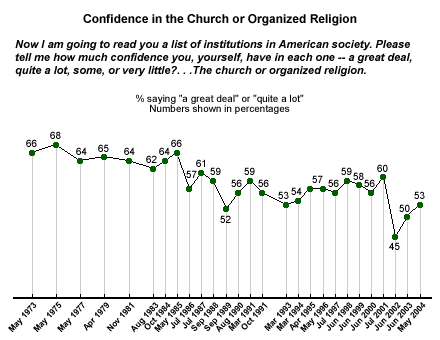After falling to an all-time low in 2002, the public's confidence in organized religion is showing signs of restoration. In June 2002, only 45% of Americans said they had a "great deal" or "quite a lot" of confidence in "the church or organized religion," down sharply from 60% in June 2001. The percentage of Americans showing this level of confidence in organized religion inched up to 50% in June 2003, and reached 53% this May.

Declining Confidence: Public Distaste for Scandal
When Gallup first asked this question in May 1973, two-thirds (66%) of Americans said they had a great deal or quite a lot of confidence in organized religion. From the mid-1970s through the mid-1980s, the public's confidence stayed relatively high -- consistently in the mid- to upper-60% range.
But in a July 1986 Gallup Poll, confidence dropped nine percentage points to 57%, down from 66% in May 1985. In 1987, confidence rose to 61% and was essentially the same the next year (59%). However, in 1989, that figure fell to 52%. After climbing back to 59% in 1991, confidence dropped again to 53% in March 1993. And after slowly rising to 60% by June 2001, confidence then fell to its low point of 45% in June 2002.
What caused the drop-offs in confidence with organized religion in 1986, 1989, 1993, and 2001? The most likely possible explanations are the high-profile scandals that rocked the U.S. religious scene in or around those years.
The mid-1980s marked the beginning of the televangelist scandals that affected the ministries of Jim Bakker, Jimmy Swaggart, and Oral Roberts, among others. Controversy about sexual scandals and financial misconduct among televangelists began in 1986 and reached its peak in 1989 with Bakker's trial and conviction on fraud and conspiracy charges. The scandals may have dealt a blow to the public's confidence that year. The September 1989 Gallup Poll, conducted during Bakker's trial, recorded a seven-point drop in the percentage of Americans who had "a great deal" or "quite a lot" of confidence in organized religion.
The March 1993 decline may have been influenced by the 1992 and 1993 revelations of child sexual abuse by Catholic priests. As a reaction to accusations and confessions of abuse, the U.S. Conference of Catholic Bishops established an ad hoc committee to aid victims and families and set guidelines for bishops dealing with abusers.
Similarly, the June 2002 drop to 45%, the lowest confidence rating of organized religion that Gallup has ever measured, was probably also driven largely by high-profile child sexual abuse scandals that shook the Catholic Church that year. It appears that the public is now regaining confidence in the church and organized religion, albeit slowly. However, the current confidence level remains far below its high of 68%, measured in May 1975.
Higher Confidence in the Church Than in Most Other Institutions
As the image of organized religion sees a recovery in the eyes of Americans, it's important to keep in mind that while public confidence in it has taken some hits over the past 30 years, Americans still hold it in relatively high regard relative to other prominent social institutions. Until July 1986, the church and organized religion ranked first in terms of the public's confidence in institutions. Since 1993, the military and the police have consistently been among the institutions garnering the most confidence from the public.
